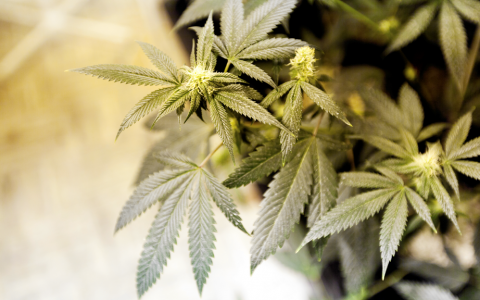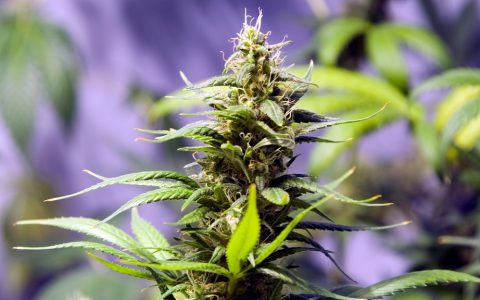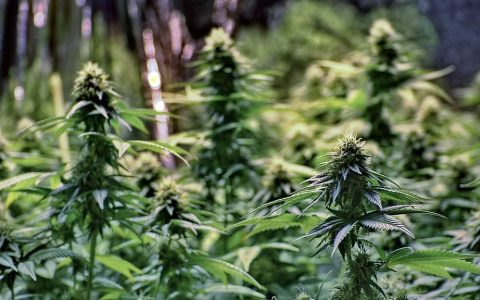The information below is published by 
How to Grow Marijuana Outdoors: A Beginner’s Guide

Growing your own cannabis can be a fun and rewarding experience, but it can also be challenging, frustrating, and expensive. For the first-time grower with limited resources, an indoor grow can prove too costly to be an option. The good news is that a small outdoor garden can yield plenty of quality cannabis without a large monetary investment. If you have access to a sunny spot in a private yard or even on a balcony, terrace, or rooftop, you can successfully grow cannabis. Our guide to outdoor growing will go over the different factors you need to consider in order to set up your first outdoor grow.
Step 1: Consider the Climate

It’s crucial to have a good understanding of the climate in the area where you live. Cannabis is highly adaptable to various conditions, but is still susceptible to extreme weather. Sustained temperatures above 86°F will cause your plants to stop growing, while temperatures below 55°F can also cause damage and stunting, even death. Heavy rains and high winds can cause physical damage to plants and reduce yields, and excessive moisture can lead to mold and powdery mildew, especially during flowering.
In addition to weather patterns, you need to understand how the length of day changes seasonally in your area. For example, at 32° N latitude (San Diego), you will experience just over 14 hours of daylight on the summer solstice (the longest day of the year), while at 47° N (Seattle) you will have about 16 hours of daylight on the same day.
One useful resource is Sunset Magazine’s climate zone map, which takes multiple factors like elevation and proximity to large bodies of water into consideration, unlike the USDA hardiness zone maps. It’s also a good idea to utilize local resources, as experienced gardeners in your area will have a wealth of knowledge about growing flowers and vegetables that can be applied to growing cannabis. If you have some experience gardening and growing veggies, you might also find that growing cannabis outdoors is a fairly easy endeavor.
Step 2: Pick a Location

Choosing the location for your outdoor garden will be the most important decision you make, especially if you’re planting in the ground or in large, immobile containers (some plants grow outdoors in containers that can be moved around depending on the weather and location of the sun). Your cannabis plants should receive at least 5 to 6 hours of direct sunlight per day, ideally during midday when the quality of light is the best.
If you live in an area where sustained daytime temperatures are above 86°F, you might want to choose a spot that gets direct sun early in the day and filtered sun during the hottest parts of the day. An area that gets a constant breeze is also a good choice in hot climates, although this will increase water consumption. On the other hand, if you live in an area that sees a lot of high winds, you should consider planting near a windbreak of some sort, like a wall, fence, or large shrubbery. Those who live in cooler climates can benefit from planting near a feature that retains heat, like a south-facing brick wall or fence, while those in hot areas will definitely want to avoid these spots.
Finally, you will want to consider privacy and security. Most people will want to conceal their gardens from judgmental neighbors and potential thieves. Tall fences and large shrubs or trees are your best bet, unless you happen to live in a secluded area. Some folks plant in containers on balconies or rooftops that are shielded from view, while some build heavy-gauge wire cages to keep thieves and animals at bay. Whatever you decide to do, remember that outdoor cannabis plants can grow to 15 feet tall or more, so plan accordingly.
Step 3: Acquire Some Soil

Soil is made up of three basic components in various ratios:
- Clay
- Sand
- Silt
Cannabis plants need well-drained, slightly acidic soil rich with organic matter in order to thrive. If you decide to plant directly in the ground, you’ll need to understand your soil composition and amend it accordingly.
Heavy clay soils drain slowly and don’t hold oxygen well, so they will need to be heavily amended. At least a month before you plant, dig large holes where you’ll be placing your cannabis plants and mix in large amounts of compost, manure, worm castings, or other decomposed organic matter. This will provide aeration and drainage as well as nutrients for the plants.
Sandy soil is easy to work, drains very well, and warms quickly, but doesn’t hold nutrients well, especially in rainy environments. Again, you will want to dig large holes for your plants and add things like compost, peat moss, and coco coir, which will help bind the soil together, providing food and air circulation. In hot climates, sandy soil should be mulched to help with water retention and to keep roots from getting too hot.
Silty soil is the ideal growing medium. It’s easy to work, warms quickly, holds moisture while also having good drainage, and contains a lot of nutrients. The best silty loam is found in prehistoric riverbeds and lake bottoms. This dark, crumbly soil is the most fertile, and will likely need little or no amendment.
If you really want to ensure good results and minimize headaches, having your soil tested is easy and relatively inexpensive. A soil testing service will tell you the makeup and pH of your soil, notify you of any contaminants, and also recommend amending materials and fertilizers.
Step 4: Get Some Fertilizer

Cannabis plants require a large amount of food over their lifecycle, mainly in the form of nitrogen, phosphorus, and potassium, and how you choose to feed them will depend on your methods and soil composition.
Commercial fertilizers aimed at home gardeners can be used if you have a good understanding of how they work and what your plants need, but should generally be avoided by less experienced growers (particularly long-release granular fertilizer like Miracle Gro). You can purchase nutrient solutions designed specifically for cannabis from your local grow shop, but these are often expensive and can damage soil bacteria as they are generally composed of synthetic mineral salts and intended for indoor, soil-less growing.
Many long-time outdoor growers are dedicated to organic methods of fertilization because it takes full advantage of the microbial life in the soil and minimizes harmful runoff. There are many different natural and organic fertilizers available at your local home and garden store like blood meal, bone meal, fish meal, bat guano, and kelp meal. Educating yourself about what they are and how they work will be extremely useful.
Concentrate on the products that are least expensive and most readily available. Some of these materials release their nutrients quickly and are easily used by the plant, while others take months or years to release food that is useable. If done correctly, you can mix in a few of these products with your soil amendments to provide enough nutrition for the entire life of your plants. Again, having your soil tested can provide very useful information on the types and amounts of fertilizer you should use. If you are unsure how much to use, be conservative; you can always top dress your plants if they start to show deficiencies.
Another method of fertilization being used more and more often these days is organic pre-fertilized soil, aka “super-soil,” which can be homemade or store-bought. Either way, it is more expensive than simply amending the soil in your garden, but it requires almost no thought, as all the required nutrients are already there. Simply dig large holes for your plants, fill them halfway with super-soil, and top with potting soil.
Step 5: Give Your Cannabis Plants Water

While outdoor cannabis gardens have the benefits of rain and groundwater not found indoors, you will most likely need to water your plants frequently, especially in the hotter summer months. Large cannabis plants can use up to 10 gallons of water every day in warm weather. Growers who live in hot, arid places will often dig down and place clay soil or rocks below their planting holes to slow drainage, or plant in shallow depressions that act to funnel runoff towards the plants. Adding water-absorbing polymer crystals to the soil is another good way to improve water retention.
If you live in a particularly rainy climate, you may need to take steps to improve drainage around your garden, as cannabis roots are very susceptible to fungal diseases when they are in waterlogged conditions. These techniques include:
- Planting in raised beds or mounds
- Digging ditches that direct water away from the garden
- Adding things like gravel, clay pebbles, and perlite to the soil
If you’re using tap or well water, it’s a good idea to test it first. Water may contain high levels of dissolved minerals that can build up in the soil and affect the pH level, or it might have high levels of chlorine which can kill beneficial soil life. Many people filter their water for this reason.
Container gardens dry out much quicker than those planted in the ground, and will often need to be watered every day. Plants grown in hot and/or windy conditions will need to be watered more frequently as well; high temperatures and winds force the plant to transpire at a greater rate. Remember that over-watering is the most common mistake made by rookie growers. The rule of thumb is to water deeply, then wait until the top inch of soil is completely dry before watering again. An inexpensive soil moisture meter is a good tool for the beginner to have.
Step 6. Choose Your Container Gardens

Container gardens are often a good choice for people who don’t have the ideal spot to grow or have really terrible soil conditions. There are numerous benefits to growing outdoors in containers, but there are drawbacks as well. If you’re unable to perform the heavy labor involved with digging holes and amending soil, containers can be the only way for you to grow your own cannabis.
If you don’t have a suitable patch of earth to make a garden, containers can be placed on decks, patios, or rooftops, and moved around during the day to take advantage of as much sun as possible or to shield the plants from excessive heat or wind. Additionally, you may use regular cannabis nutrients designed for indoor grows, taking much of the guesswork out of fertilizing your plants.
These benefits lead many first-timers to use containers for their initial outdoor grow. However, plants grown in pots, buckets, or barrels will likely be much smaller than those planted in the ground because their root growth is restricted to the size of the container. In a broad sense, the size of the pot will determine the size of the plant, although it’s possible to grow large plants in small containers if proper technique is used.
In general, five gallons is the smallest size you would want to use, and 10 gallons or larger is recommended for hearty plants. Regardless of the size, you will want to protect the roots of your plants from overheating during warm weather, as pots of soil can rapidly reach 90°F or more on a hot day. This will severely limit your plants’ growth, so be sure to shade your containers from direct sunlight. And finally, you will need to water your container garden much more frequently, even every day during the summer. Water your plants deeply in the morning so they have an adequate supply throughout the day.
Step 7: Protect Your Cannabis Plants

Without the ability to control the environment as you would indoors, outdoor cannabis growers have had to figure out how to protect their plants from storms and other weather events that could damage or even kill them.
Temperature Changes
Temperatures below 40°F can quickly damage most varieties of cannabis, so if you live in a climate where late spring or early fall frosts are a common occurrence, using cloches, hot caps, cold frames, or other protective enclosures will likely be necessary.
Wind Conditions
High winds can break branches, damage trichomes, and stress your plants, leaving them vulnerable to pests and disease. If your garden is located in a particularly windy spot, or you’re expecting a particularly heavy blow, erecting some sort of windbreak is highly recommended. This can be as easy as attaching perforated plastic sheeting to garden stakes around your plants.
Rain
While helpful for watering your garden, rain is generally seen as a nuisance by cannabis growers as it can severely damage your crop and cause mold and mildew issues, especially when plants are flowering. If summer and early fall rains are likely in your area, it’s wise to choose a variety that has a natural resistance to mold. Make sure to fully support your plants with cages or stakes because rainwater will collect on leaves and buds, weighing your plants down and breaking branches. Otherwise, you can use plastic sheeting and stakes to build temporary shelters over your plants when you know rain is on the way.
Pests
Protecting your cannabis garden from pests can be challenging. Animal pests like deer and rabbits are dealt with easily enough: fences and cages will keep them at bay. When is comes to the vast array of crawling and flying insects that can attack your plants, things get a little more difficult. The best protection is to simply keep your plants healthy; most vigorous cannabis plants have a natural resistance to pests that makes minor infestations easy to deal with. It’s also a good idea to keep your plants separated from other flowers, vegetables, and ornamentals as pests from these can easily spread.
Examine your cannabis plants daily for signs of pests. An infestation is far easier to deal with if you catch it early. Washing plants with a mild solution of soap and water can stop a minor infestation in its tracks. In the event that doesn’t work, there are many organic insecticides designed for use on cannabis, often derived from neem or other natural botanical extracts. These are quite effective when used correctly.
Step 8: Decide on Genetics

The success of your outdoor cannabis grow will depend heavily on choosing the right variety for your climate and location. If you live in an area with a history of cannabis growing, chances are good that there are many strains that have been proven successful there, or were even bred specifically for your climate.
Mismatched Climates
Some strains simply don’t produce well in unfamiliar climates, the prime example being tropical sativa varieties. Cannabis plants start flowering when days start to get shorter; these tropical plants are acclimated to areas closer to the equator where the length of day doesn’t vary as much. When you attempt to grow them in northern latitudes, they begin flowering much too late to take advantage of the late-summer sun. These strains can also take 50-100% longer to finish flowering, meaning they sometimes don’t finish until December. If you live in southern California, you may grow these varieties without any problems; in Seattle or Vancouver, B.C. they just won’t produce before being killed by lack of light, heavy rain and cold weather.
Cannabis Seeds vs. Clones
While most indoor growers grow from clones (rooted cuttings that will be genetically identical to the plant they were taken from), outdoor growers often prefer to grow from seed. Both options have their advantages and drawbacks.
Cloning requires a “mother plant,” which is a plant kept under 16-24 hours of light per day to prevent it from flowering. Alternately, you may purchase clones from a local dispensary. The benefit to this route is that “mother plants” are generally proven to produce quality bud, and all clones will be female plants that exhibit the same characteristics. These clones will need to be rooted indoors, and then hardened off much like you would a seedling that was started indoors.
One drawback is that clones tend to be less vigorous than seeds, meaning plants are smaller and yield less, although you can still produce large plants by growing clones indoors in late winter and early spring to get a head start on the growing season. Also, cloned plants don’t develop a taproot, the thick central root that penetrates deep into the ground to stabilize the plant and take up ground water, so they’re more susceptible to high winds and drought.
Plants grown from seed are generally more hearty as young plants when compared to clones. Cannabis seedlings are tolerant of low temperatures and wet conditions, meaning you can plant seeds directly into the garden in early spring, even in cooler, wetter climates. If you choose to start them indoors, though, they will still need to be hardened off before transplanting.
The main drawback to growing from seed is that there is no guarantee as to what you will end up with. Each cannabis seed is unique and will produce a different plant, so unless you choose an inbred seed line, you can’t really be sure what the final product will be like. Also, regular cannabis seeds produce both males and females, so you will have to sex your plants when they reach sexual maturity and cull any males. For this reason, many people choose feminized seeds.
Autoflowering seeds are another popular choice for outdoor growing, as they start blooming as soon as they reach maturity regardless of the length of day. Many gardeners in temperate climates will get two crops every year using autoflowering seeds, one planted late winter or early spring and another planted early summer.
Hopefully you now have enough knowledge to successfully start your own outdoor cannabis garden. Cultivating and growing plants should be an enjoyable and rewarding pastime, so remember, spend lots of time with your plants, and have fun!









